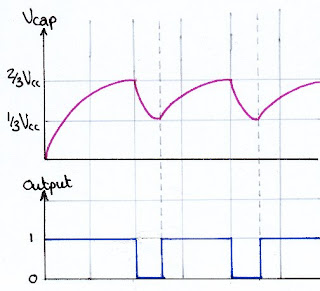Astable means not stable in any state, so this circuit will alternate
between on and off and create a square wave output. The on and off
times can be adjusted by changing the values of R1, R2
and the capacitor. This changes the RC time constant.
- The three resistors at the top of the 555 timer create a voltage divider to give 1/3 and 2/3 of the supply voltage.
- When the supply voltage is switched on, the SR flip flop is currently unset, not Q will be high and so the transistor will be saturated and the current will just flow to ground and the capacitor will not charge.
- When the trigger voltage (this could be seen as the input) – Pin 2 – falls below 1/3 of the supply voltage the first comparator saturates, setting the SR and not Q will be low. This means that the transistor will not be saturated and the current will flow through the capacitor and it will start to charge. The inverting amplifier will invert this low signal and the output – Pin 3 – will be high. (The first “on period” will be longer as the capacitor is charging from 0, after this it charges from 1/3 so will settle into a repeated pattern)
- When the voltage over the capacitor (and therefore the threshold voltage – Pin 6) reaches 2/3 of the supply voltage the second comparator will saturate positively, resetting the SR, not Q will be high and the transistor will saturate. Because of the potential difference over the charged capacitor, current will now flow through pin 7, through the transistor to ground, discharging the capacitor. The inverting amplifier will invert the high signal and the output – Pin 3 – will now be low.
- As long as the trigger voltage – Pin 2 – remains below 1/3 of the supply voltage, the first comparator will remain saturated and so the set to the SR will be high and so as soon as the reset pin is low (because the capacitor has discharged and so the voltage to the + terminal of the second comparator will be lower than 2/3 of the supply voltage and therefore it will saturate negatively) the SR will set and the whole cycle will start again.

